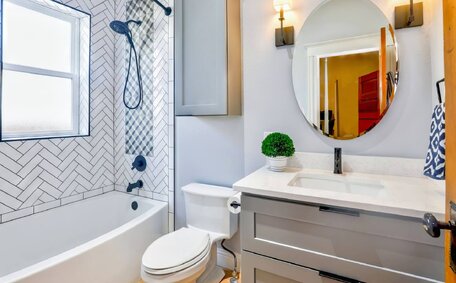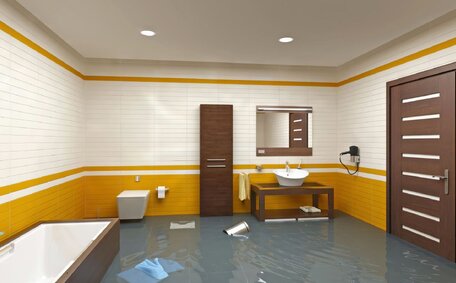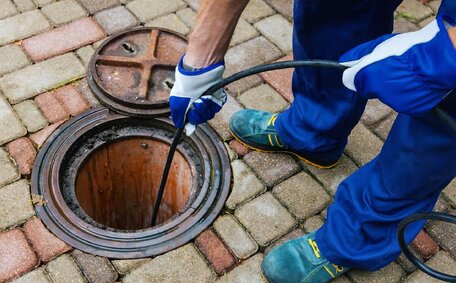Determining Gas Availability and Service in Your Area
When planning all new construction in the Cherrybrook area, one of the first things to determine is whether a natural gas service line is available at your site.
Please contact your local gas network provider, such as Jemena or AGL, to inquire if gas lines run near your property. They can inform you if new connections for gas are viable considering the proximity and capacity of the gas line.
You’ll also want to verify that gas appliances are permitted under local council regulations if aiming to minimise gas emissions for a net zero home. New NSW government legislation mandates a ban gas new policy in new low-rise residential buildings starting 2024, yet permits gas usage when offset by renewable sources.
Discovering more about whether gas available is compatible with the property and aligned with sustainability goals is key. This enables thorough strategising around gas meter locations, type gas appliances, and builder requirements in advance of the build. Reaching out to licenced gas fitters for recommendations can answer your queries on why should you choose specific setups to further optimise your installation.
Selecting Gas Appliances for Your New Home
While preparing for gas use, thoughtfully decide which models of appliances will serve your needs effectively and conform with energy conservation targets in your new residential space. Evaluate options on performance, operating costs, safety, and environmental impact, especially when considering your appliances, such as gas hot water systems.
For culinary purposes, contemporary your chosen gas cooktops and ranges provide immediate temperature regulation and swift boiling capacities. But induction cooktops are energy-efficient alternatives to review. With hot water systems, examine the pros and cons of gas versus electric boosted solar. With hot water systems, examine the pros and cons of gas versus electric boosted solar.
Discuss specifications with builders and browse models rated highly for energy savings. Discuss specifications with builders and browse models rated highly for energy savings. Discuss specifications with builders and browse models rated highly for energy savings.
We recommend proper appliance selection right from the start to maximise functionality and help you save money for years to come.
Hiring Licensed Gas Fitters
When installing or modifying gas systems in a home, it is crucial to hire qualified professionals licenced specifically for gas fitting work. Employing registered gas experts guarantees paramount gas safety and they must be able to ensure compliance with stringent industry standards for appliances and infrastructure.
Verify technicians hold a gas new work licence for the needed tasks through Service NSW. All tradespeople executing gasfitting tasks must possess a suitable class of accreditation congruent with the work’s scope, in line with national construction standards. Class A licences cover most new dwellings and minor commercial jobs - suitable for appliance installs.
No matter how complex the task, Class B applies for intricate gas works at commercial buildings and industrial plants.
Check licencing status online or request certificates directly. Documenting licences protects liability.
Then validate additional accreditations like manufacturer training for specific appliance models being installed. Adhering to best practises reduces the immense risks inherent with pressurised gas.
Collaborating with Builders on Gas Connection Setup
Installing gas systems in new home builds necessitates collaboration between homeowners, your builder, and licensed gas fitters to ensure seamless integration. The new development design construction stage offers a pivotal opportunity to synchronise prerequisites for meter placements, piping, appliance varieties, and connection timelines in the new abodes.
Open communication channels early when finalising house plans. Subsequently, ask for their professional opinion on practicability, pertinent construction codes, and the sequence of development.
Outline to your builder what you’ll need regarding gas utilisation within the home, from heating systems to cooktops and outdoor features. They can integrate provisions for gas infrastructure like pre-allocated metre box spacing while managing other utilities planned.
Be ready to liaise with builders frequently about how to use gas within your property’s design. Prompt approvals accelerate suitable provisions.
Expect to confirm appliance choices, pipe dimensions, Trenching routes for gas your mains supply, and metre delivery timings throughout the project. Be aware that scheduling for all gas connections is timed near the culmination of the build, given that appliances can’t stay dormant excessively post-installation. With coordinated efforts, builders and gas tradesworkers will ensure homes are apply new connections to gas networks, meeting occupant needs.
Preparing Your Site for Gas Infrastructure
Preparing your site meticulously, including considerations for your plumbing drainage, is essential for an installation without hitches. Ensure everything is set before dig, with easy access to the planned gas meter box location by clearing an unobstructed pathway in accordance with your distributor’s requirements.
The gas meter box should be securely affixed on an even area at a distance from barriers, constructions, and outdoor faucets. Install protective marker posts around the gas metre site to prevent accidental damage during other site works. Make sure all subterranean pipes and wires are installed at specified depths to prevent interference with forthcoming gas supply conduits.
Provide precise property location information, projected finalisation dates, and types of gas appliances to your distributor upon submitting the request gas connection form. This helps coordinate appropriate metre sizing and timely hook-up. Consider upgrading metre capacity if your intended gas usage might increase in future through additions.
While you oversee civil works, your gas fitter can skillfully coordinate inspections, certificates, and appliance installs per the completion timeline. By proactively addressing site conditions and paperwork, costly revisions down the track are prevented - ensuring you can complete your build on schedule.
Installing Gas Piping and Components
When installing gas pipes and fittings in a new home build, work closely with your licenced gas fitter to lay the piping network according to building plans. Use rigid copper, stainless steel, or approved polyethylene materials to handle gas pressure demands safely.
Take into account pipe routing for easy access to the hot water system for future maintenance needs. Affix warning labels along pipe routes to alert tradesworkers.
Coordinate with electricians regarding safe clearances between gas and electrical lines within walls and ceilings. Slope horizontal pipes with a uniform grade to allow moisture drainage to appliances.
Your gas expert will ascertain the suitable pipe sizes to cater for the gas demands of connected appliances, including the water system. Follow manufacturer instructions carefully when installing water heaters, cooktops, pool heaters and other gas units connected to your water supply, while verifying safe operating pressures.
Oversize where possible to allow for potential expansions. Use isolation valves to enable individual component maintenance without full system shutdowns.
Full testing protocols apply before concealing pipework. Your gas fitter confirms leak detection, appliance ignition functioning and pressure tests comply with gas authority regulations for certification. Provide access for subsequent inspections to validate all prescribed safety standards are fulfilled before gas connection approval.
Choosing an Optimal Gas Meter Location
When selecting a location for your home’s gas metre box, consider access, safety, and aesthetics while meeting distributor and building code requirements.
Ensure there no metre assembly is situated in a well-ventilated area, at least 3 metres from openings into the building or ignition sources. Ensure easy access for metre reading without obstructions like fences or plants. The area should allow appliance pressure testing and facilitate maintenance.
Aim for an unobtrusive yet visible site to blend functionality with home design. Side wall placements often work well to discreetly integrate. Provide at least 600 mm clearance space around the gas metre, plus added distance from electrical, water and gas appliance vents as mandated.
Finalizing Gas Meter Installation
Completing your new gas metre installation involves coordination between builders, homeowners, and utility providers leading up to the metre set date. Engage with your distributor approximately 8 business days or more in advance to assure them of site readiness for standard connections, or sooner for intricate projects.
On the day of connection, provide clear site access to enable the authorised gas technician to position the metre unit, assemble pipework to specifications, and validate safe functionality. Your plumber can undertake the final connections to appliances post the accredited gas professional’s integration with the distribution grid.
Expect testing of operating pressures, ignition sequencing, and leak detection as part of the commissioning process per AS/NZS 5601.1 safety standards. Your energy retailer will schedule a final reading for account establishment once all compliance certificates get lodged. Refer to local requirements, such as those laid out by the state government, as inspection regimes vary across Australian states.
With our guidance, we can help ensure meticulous planning so the metre installation day concludes all coordination efforts to safely receive the gas supply. Before commencing works, thoroughly understand the entire procedure for your new developments - enabling fluid progress up to the ultimate connection stage for official completion.
Connecting and Using Gas Appliances
The final step after your gas metre installation is connecting appliances by a licenced professional. With the distribution connection completed and safety checks passed, the gas fitter can proceed to link cooktops, water heaters, space heaters and more to activate usage.
Verify appliance compatibility via energy supply pressures with available gas before installation. Conduct leak testing on joints and confirm ignition sequencing functions per the manufacturer. Ascertain if there any discrepancies by checking appliance data plates to validate specifications align with network supplies in your area.
Once appliances operate properly, obtain certification of compliance from your gas fitter to retain for records. Inform your gas retailer following the finalisation, to initiate the billing process according to usage. Refer to appliance manuals for operating instructions and maintain services as recommended for optimal safety.
Meeting Safety Standards and Regulations
Adhering to safety laws and codes is paramount when installing gas systems in new homes. Australian Standard AS/NZS 5601.1 governs gas installations and consumer piping networks, enforced via state regulations.
All works must adhere to the latest construction code, performed by qualified gas fitters holding an appropriate class licence. On completing an installation, the technician validates compliance through a Gas System Compliance Certificate listing the standards applied.
Key areas covered relate to materials, design, testing, inspection, purging, and documentation across residential commercial and industrial gas projects. Requirements address the pressure capacity of pipes, safety controls, ventilation for appliances, clearance distances, signage, gas leakage, and more. Systems require certification before the network supplier activates metre connection.
Further codes apply for specific gas components like water heating systems and cooktops. The rigorous attention to member safety seeks to eliminate risks from fire, explosion, or toxic gas exposure.
Homeowners ought to ensure that gas technicians observe all required regulations when fitting or modifying existing gas networks in new structures. Obtain the compliance paperwork to retain onsite within your records. Staying up to code remains essential through the occupancy phase as well during maintenance or renovations involving the gas system.






